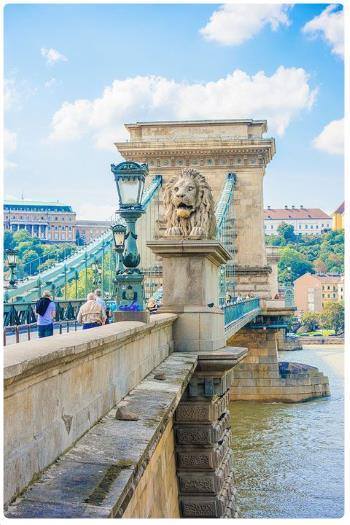|
Chain Bridge in Budapest
|
The
Chain Bridge is the oldest bridge in
Budapest,
the first bridge that has allowed to connect the two cities of Buda
and Pest. Before then they were independent of each other until 1873.
The project for its construction was entrusted to William Tierney Clark
of England and Adam Clark of Scotland (two unrelated UK engineers) on
the initiative of the Hungarian Count István Széchenyi. The engineers
chose the solution of a suspended bridge whose central span, between two
pylons, was at that time one of the largest in the world (202 m long).
|
|
In 1830 Budapest, then the second city of the Austrian Empire, had no fixed
bridge over the Danube. A bridge of boats, which was dismantled in winter to
avoid the damage caused by the icy river, allowed only uncomfortable connections
between the three then still divided cities of Buda, Pest and Obuda.
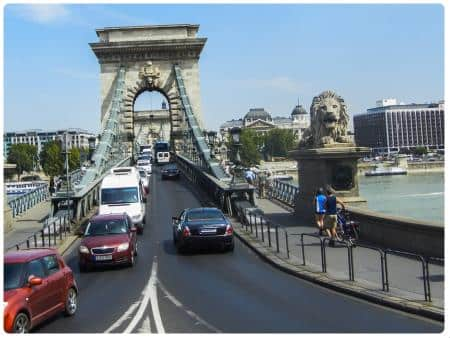 In
the Hungarian society of the time, Count Széchenyì, a man of great skill,
determination and fervent proponent of the social progress of Hungarians, shone.
Convinced of the absolute necessity of a stable crossing, the Count travelled
twice to Great Britain to find designers able to guarantee the construction of a
bridge that, given the size and width of the Danube, was considered very
difficult to carry out. Finally, Széchenyì met William Tierney Clark, who agreed
to design a suspended bridge.o. In
the Hungarian society of the time, Count Széchenyì, a man of great skill,
determination and fervent proponent of the social progress of Hungarians, shone.
Convinced of the absolute necessity of a stable crossing, the Count travelled
twice to Great Britain to find designers able to guarantee the construction of a
bridge that, given the size and width of the Danube, was considered very
difficult to carry out. Finally, Széchenyì met William Tierney Clark, who agreed
to design a suspended bridge.o.
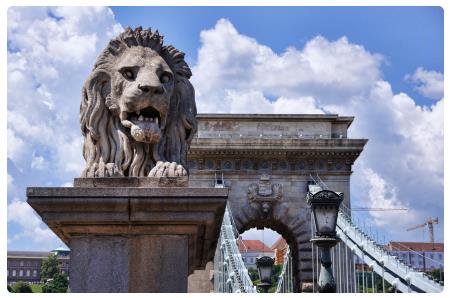 Since
only one span was too long, the project included a large central span, which
did not hinder river traffic, and two high pylons located near the banks.
The construction works were directed by the Scottish architect Adam Clark,
with the same surname but not relative to the designer, who also built a
gallery extending to the bridge, a gallery of great elegance, with a sixth
acute section, to connect the upper districts of Budapest. At that time,
steel ropes were not very well known from a technological point of view and
were difficult to find in suitable lengths. Since
only one span was too long, the project included a large central span, which
did not hinder river traffic, and two high pylons located near the banks.
The construction works were directed by the Scottish architect Adam Clark,
with the same surname but not relative to the designer, who also built a
gallery extending to the bridge, a gallery of great elegance, with a sixth
acute section, to connect the upper districts of Budapest. At that time,
steel ropes were not very well known from a technological point of view and
were difficult to find in suitable lengths.
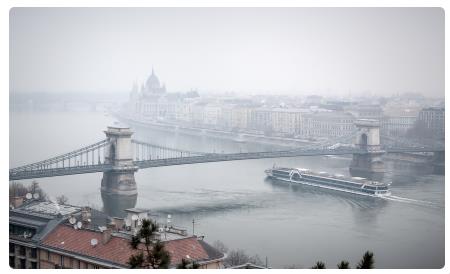 In
1849, the 350-metre-long tunnel was built that connects the bridge to the
Castle district of the hillside and that lies just below it (the bridge and
the tunnel have curiously the same length). During the Second World War the
bridge was destroyed by the Germans (to counteract the advance of Soviet
troops) and rebuilt after the Second World War, since 1989 it has become a
symbol of Hungarian freedom, marking the end of the Soviet period in the
country and Eastern Europe. In
1849, the 350-metre-long tunnel was built that connects the bridge to the
Castle district of the hillside and that lies just below it (the bridge and
the tunnel have curiously the same length). During the Second World War the
bridge was destroyed by the Germans (to counteract the advance of Soviet
troops) and rebuilt after the Second World War, since 1989 it has become a
symbol of Hungarian freedom, marking the end of the Soviet period in the
country and Eastern Europe.
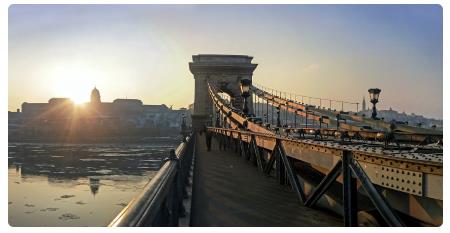 The
bridge, which began in 1839 and was only completed and opened ten years later,
was the first bridge between the two banks of the Danube. It was barely a month
after the heads of the independence war, lost against the Habsburgs, had been
executed. Eighteen years later, in 1867 Austria and Hungary signed the
"Compromise", which lasted half a century, until the end of the First World War.
For fifty years there was an illusion: it was enough with wars. They laid the
foundations for the Duplice Monarchy. A few more years later and in 1873, the
inhabitants of Buda, Pest and Obuda decided to join the new
capital. First, then, the bridge. Then, the name, Budapest, and the functions of
a metropolis that began to exist on the atlases. Buda is the hill, the royal
village, the memory of Àrpàd, the powerful magic chief who conquered the
territories of the present Hungary around 895 A. D., founder of the Arpadi
dynasty, reigning house of Hungary until 1301; of Anjou, of János
Hunyadi, leader against the Turks. Pest was the new, the bourgeoisie,
finance, trade and living rooms. The
bridge, which began in 1839 and was only completed and opened ten years later,
was the first bridge between the two banks of the Danube. It was barely a month
after the heads of the independence war, lost against the Habsburgs, had been
executed. Eighteen years later, in 1867 Austria and Hungary signed the
"Compromise", which lasted half a century, until the end of the First World War.
For fifty years there was an illusion: it was enough with wars. They laid the
foundations for the Duplice Monarchy. A few more years later and in 1873, the
inhabitants of Buda, Pest and Obuda decided to join the new
capital. First, then, the bridge. Then, the name, Budapest, and the functions of
a metropolis that began to exist on the atlases. Buda is the hill, the royal
village, the memory of Àrpàd, the powerful magic chief who conquered the
territories of the present Hungary around 895 A. D., founder of the Arpadi
dynasty, reigning house of Hungary until 1301; of Anjou, of János
Hunyadi, leader against the Turks. Pest was the new, the bourgeoisie,
finance, trade and living rooms.
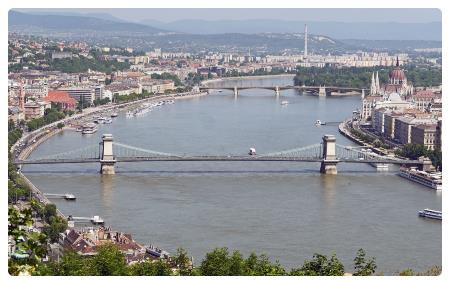 At
the beginning of the 19th century, the three villages together were
demographically irrelevant. Conversely, at the end of the century, the
metropolis was the eighth of the continent. A swirling progression. In
little more than twenty years the population doubled, the city became modern.
Underground, trams, gas, electricity. Neo-Renaissance, neoclassical,
neo-Gothic, jugendstil (or Art Nouveau if you like), bauhaus. Then
socialist realism, rationalism, functionalism.... At
the beginning of the 19th century, the three villages together were
demographically irrelevant. Conversely, at the end of the century, the
metropolis was the eighth of the continent. A swirling progression. In
little more than twenty years the population doubled, the city became modern.
Underground, trams, gas, electricity. Neo-Renaissance, neoclassical,
neo-Gothic, jugendstil (or Art Nouveau if you like), bauhaus. Then
socialist realism, rationalism, functionalism....
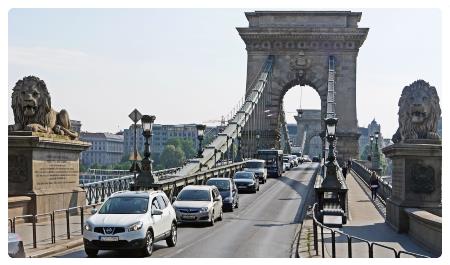 Adam
Clark, married a Hungarian girl and settled permanently in Budapest. His
memory was named after the large square that gives access to the bridge.
Clark was so proud of his project that he started the bet that if only one
defect had been found in the construction, he would plunge from the bridge
into the Danube. After many weeks the defect was found (although it
certainly did not depend on Clark): the lions guarding the bridge had been
carved without tongue. Clark lost the bet, he wanted to honor her, but as he
was a great swimmer, he came out free from the dangerous dive. Adam
Clark, married a Hungarian girl and settled permanently in Budapest. His
memory was named after the large square that gives access to the bridge.
Clark was so proud of his project that he started the bet that if only one
defect had been found in the construction, he would plunge from the bridge
into the Danube. After many weeks the defect was found (although it
certainly did not depend on Clark): the lions guarding the bridge had been
carved without tongue. Clark lost the bet, he wanted to honor her, but as he
was a great swimmer, he came out free from the dangerous dive.
At the entrance of the Chain Bridge there is still a strange stone doughnut
at the entrance to the bridge. It is the Monument to the Zero Kilometer.
It was the centre of Hungary. The point to measure the roads leading to the
borders of an empire that would soon collapse to make way for other myths
and illusions.
The bridge was blown up by the Germans at the end of the Second World War;
after the conflict, the inhabitants of Budapest wanted to rebuild it in
shapes and characteristics identical to the original. The bridge was
reopened in 1949, exactly one hundred years after the date of the first
inauguration.
Chain Bridge (Széchenyi
lánchíd)
Between Roosvelt square and Clark square
Area: Historic centre
Budapest
Where is it located?
Back Up
Ostelli Ungheria
Hotel in Ungheria
Carte de Budapest Karte von Budapest Mapa Budapest Map of Budapest
Carte de Hongrie Karte von Urgan
Mapa Hungría Map of Hungary
|
